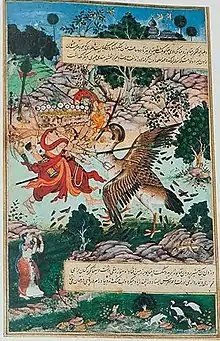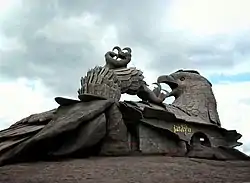Jatayu
Jatayu (Sanskrit: जटायुः, IAST: Jaṭāyuḥ) is a demigod in the Hindu epic Ramayana, who has the form of either an eagle or a vulture.[1] He is the younger son of Aruṇa and his wife Shyeni, the brother of Sampati, as well as the nephew of Garuda. He is also an old friend of King Dasharatha, Rama's father.
| Jatayu | |
|---|---|
 | |
| Texts | Ramayana and its other versions |
| Personal information | |
| Parents |
|
| Siblings | Sampati |
Legend


Flight towards the Sun
During their youth, Jatayu and his elder brother, Sampati, under a wager, flew towards Surya, the solar deity. Jatayu, careless due to his youthfulness, outflew his brother, and entered the Sūryamaṇḍala, the orbit of the Sun, during noon. Due to the blazing heat of Surya, his wings started to get scorched. In a desperate bid to rescue his brother, Sampati flew ahead of him, spreading his wings wide open to shield him. As a consequence, it was Sampati who had his wings burnt, descending towards the Vindhya mountains. Incapacitated, he spent the rest of his life under the protection of a sage named Nishakara, who performed a penance in the mountains. Jatayu never met his brother again.[2]
Battle against Ravana
The Araṇya-Kāṇḍa of the Ramayana mentions that Jatayu is the "King of Vultures"(gṛdhrarāja).[3] According to the epic, the rakshasa Ravana was abducting the avatar of Lakshmi, Sita, when Jatayu tried to rescue her. Jatayu fought valiantly with Ravana, but as Jatayu was very old, Ravana soon defeated him, clipping his wings, and Jatayu descended upon the earth. Rama and Lakshmana, while searching for Sita, chanced upon the stricken and dying Jatayu, who informed them of the battle with Ravana, and told them that Ravana had headed south. Jatayu then died of his wounds and Rama performed his final funeral rites.[4][5]
Veneration

- According to local lore of Kerala, it is believed that Jatayu fell on the rocks in Chadayamangalam in the Kollam district of Kerala after his wings were clipped off by Ravana. The name "Chadayamangalam" is said to be derived from "Jatayu-mangalam". Jatayu Earth's Center Nature Park in Chadayamangalam features a 61 metres (200 ft) wide statue of Jatayu, which is credited as the world's largest bird sculpture.[6]
- Lepakshi in Andhra Pradesh is also attributed as the place where Jatayu fell after being wounded by Ravana. Rama is said to have commanded the bird to rise, saying Le Pakshi (literally: "Get up, Bird" in Telugu), hence the name for the village.[7][8]
- Vijayaraghava Perumal temple in Thiruputkuli, Tamil Nadu is associated with Jatayu because the presiding deity, Vijayaraghava Perumal (a form of Rama), is believed to have performed the last rites of Jataya at this place. The water body where Jatayu fell is called Jatayu Tirtham.[4][5]
- Thirupullabhoothangudi Temple in Pullabhoothangudi, Tamil Nadu is also claimed as the location of Jatayu's last rites.[9]
See also
References
- www.wisdomlib.org (15 June 2012). "Jatayu, Jaṭāyu, Jatāyū: 19 definitions". www.wisdomlib.org. Retrieved 31 October 2022.
- www.wisdomlib.org (28 January 2019). "Story of Jaṭāyu". www.wisdomlib.org. Retrieved 1 November 2022.
- daśagrīvasthito dharme purāṇe satyasaṃśrayaḥ jaṭāyur nāma nāmnāhaṃ gṛdhrarājo mahābalaḥ — Ramayana 3.048.003
- K.V., Raman; T., Padmaja (1995). Indian Epic Values: Rāmāyaṇa and Its Impact: Proceedings of the 8th International Rāmāyaạ Conference. Peeters Publishers. p. 86. ISBN 9789068317015.
- C., Chandramouli (2003). Temples of Tamil Nadu Kancheepuram District. Directorate of Census Operations, Tamil Nadu.
- "Kerala tourism to unveil world's largest bird sculpture". The Quint. 23 May 2018. Retrieved 25 May 2018.
- "Lepakshi: Where Jatayu fell". Bangalore Mirror. Retrieved 1 April 2021.
- "Lepakshi Temple - Lepakshi:: The Treasure House of Art and Sculpture". Archived from the original on 28 March 2012. Retrieved 3 July 2012.
- R., Dr. Vijayalakshmy (2001). An introduction to religion and Philosophy - Tévarám and Tivviyappirapantam (1st ed.). Chennai: International Institute of Tamil Studies. pp. 530–1.
Bibliography
External links
- The Hindu. Rama’s paratva.
.jpg.webp)
